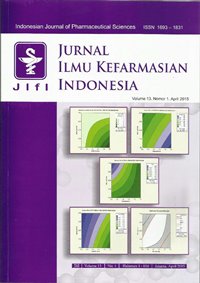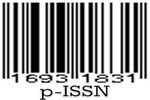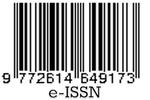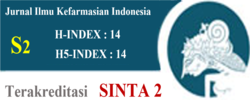Dyslipidemia as A Risk Factor of Declining Estimated Glomerular Filtration Rate (eGFR) Value on Diabetes Mellitus Type II
Abstract
Prevalence of diabetes mellitus type II is high in the world as well as in Indonesia which is 55% patient get dyslipidemia. The risk of cardiovascular disease arises on patient DM type 2 with dyslipidemia so that it is possible to make vasoconstriction in renal artery getting worse. Renal function value can mark from estimated glomerular filtration rate (eGFR). The aim of this study is to determine dyslipidemia in DM type II as risk factor on declining renal function which is marked from decreasing eGFR. This study was analytical observational with cross sectional design. This study compared eGFR between DM type II patient with and without dyslipidemia in Hospital X, Central Java, Indonesia. A hundred subject participated in this study. Data have analyzed in descriptive and Chi-Square using SPSS. Result showed Dyslipidemia on patient Diabetes Mellitus (DM) type II was not risk factor for declining renal function based on eGFR value (OR=0,711, CI95%= 0,270 – 1,875).
References
2. Departemen Kesehatan. Tahun 2030 Prevalensi Diabetes Mellitus di Indonesia Mencapai 21,3 Juta Jiwa. 2012. diambil dari http://www.depkes.go.id/ index.php/berita/press-release/414-tahun-2030- prevalensi-diabetes-melitus-di-indonesia-mencapai- 213-juta-orang.html. diakses tanggal 24 Mei 2013.
3. Fowler MJ. Microvascular and macrovascular complication of diabetes. Clinical Diabetes. 2008. 26(2):76-82.
4. American Diabetes Association. Diagnosis and classification of diabetes mellitus. Diabetes Care. 2011. 34(1):562.
5. Vijayaraghavan K. Treatment of dyslipidemia in patients with type 2 diabetes. Lipids in Health and Disease. 2010. 9:144. 6. Chehade, Gladys, and Mooradian. Dyslipidemia in type 2 diabetes: prevalence, pathophysiology, and management. Springer Link. 2013. 73(4):327-39. 7. Lin Y , and Sun Z. Current views on type 2 diabetes. Journal of Endocrinology. 2010. 204:1-11. 8. Gilani SYH, Bibi S, Ahmed N, Shah SRA. Gender differences of dyslipidemia in type 2 diabetics. J. Ayub Med. Coll. Abbottabad. 2010. 22(3):146-8.
9. Dipiro JT, Talbert RL, Yee GC, Matzke GR, Wells BG, and Posey LM. Pharmacotherapy a pathophysiologic approach. 7th Ed. New York: McGrawhill; 2008. 729.
10. Sales GF, Cardoso CR, Pereira VS, Fiszman R, and Muxfeldt ES. Prognostic significance of a reduced glomerular filtration rate and interaction with microalbuminuria in resistant hypertension : A cohort study. J. Hypertens. 2011. 29(10):2014-23. 1
11. Tsimihodimos V, Mitrogianni Z, and Elisaf M. Dyslipidemia associated with chronic kidney disease. Cardiovaskular Medicine Journal. 2011. 5:41-8.
12. National Kidney Foundation. Kidney disease outcome quality initiative (NKF KDOQI) guidelines. estimation of GFR. 2000. diambil dari www.kdoqi.org. diakses tanggal 25 Juni 2013.
13. Parhofer KG. Pathophysiology of diabetic dyslipidemia: Implications for atherogenesis and treatment. 2012. diambil dari http://www.futuremedicine.com/ doi/ abs/10.2217/clp.11.32, diakses 30 Juni 2013.
14. Parikh RM, Joshi SR, Menon PS, and Shah NS. Prevalence and pattern of diabetic dyslipidemia in Indian type 2 diabetic patients. Diabetes & Metabolic Syndrome: Clinical Research & Reviews. 2010. 4(1):10-2.
15. Triptaradol S and Aekplakorn W. Prevalence, awareness, treatment, and control of coexistence of diabetes and hypertension in Thai population. International Journal of Hypertension. 2012. 2012:1- 12.
16. Codreanu I, Sali V, Gaibu S, Suveica L, Popa S, Perico N, Ene-Iordance B, Carminati S, Feehally J, and Remuzzi G. Prevalence of hypertension and diabetes and coexistance of chronic kidney disease and cardiovascular in the population of the republic Moldova. International Journal of Hypertension. 2012. 2012:1-9.
17. Shabana S and Sasisekhar TVD. Effect of gender, age, and duration on dyslipidemia in type 2 diabetes mellitus. 2013. 5(6):104-13.
18. Mesalic L, Tupkovic E, Kendic S, and Balic D. correlation between hormonal and lipid status in women in menopause. Bosnian Journal of Basic Medical Sciences. 2008. 8(2):188-92.
19. Dong-Wei L, Jia W, Zhang-Suo L, Pei W, Gen-yang C, and Xue-zhong S. Association between dyslipidemia and chronic kidney disease: A cross-sectional study in the middle-aged and elderly chinese population. Chinese Medical Journal. 2013. 126 (7):1207–12.
20. Suchitra MM, Kumar S, Bitla AR, Rao MA, and Alok S. Atherogenic dyslipidemia in diabetic nephropathy: lipoprotein ratios and atherogenic index. International Journal of Research in Medical Science. 2013. 1(4):455-9.
21. Unuiqbo JN, Unueiqbe E, Kalo OA, Oquejiofor CO, and Onuiqbo PC. Prevalence of dyslipidemia Among adult diabetic patients with overt diabetic nephropathy in Anambra State South-East Nigeria. Niger J. Clin. Pract. 2011. 14(2):171-5.
22. Mooradian AD. Dyslipidemia in type 2 diabetes mellitus. Nat. Clin. Pract. Endocrinol. Metab. 2009. 5:150–9.
23. Smith JD. Dysfunctional HDL as a diagnostic and therapeutic target. Arterioscler Thromb Vasc Biol. 2010. 30:151-5.
24. Manoria PC, Chopra HK, Parashar SK, Dutta AL, Pinto B, Mullasari A, and Prajapati S. The nuances of atherogenic dyslipidemia in diabetes: Focus on triglycerides and current management strategies. Indian Heart Journal. 2013. 65(6):683-90.
25. Arora S. Renal function in diabetic nephropathy. World Journal of Diabetes. 2010. 1(2):48-56.
26. Mullugeta Y, Chawla R, Kedebe T, and Worku Y. Dyslipidemia associated with poor glycemic control in type 2 diabetes mellitus and the protective effect of metformin supplementatiom. Ind J. Clin Biochem. 2012. 27(4):363–9.
27. Center of Disease Control and Prevention. National chronic kidney disease fact sheet 2010. diambil dari http://www.cdc.gov/ diabetes/pubs/factsheets/kidney. htm. diakses tanggal 26 November 2013.
28. Halbesma N, Brantsma AH, Bakker SJL, Jansen DF, Stolk RP, Zeeuw DD, Jong PE, and Gansevoort RT. Gender differences in predictors of the decline of renal function in the general population. Kidney International. 2008. 74:505–12.
29. Sabolic I, Asif AR, Budach WE, Wanke C, Bahn A, and Burckhardt G. Gender differences in kidney function. Eur. J. Physiol. 2007. 455:397–429.
30. Yanes LL, Sartori-Valinotti JC, and Reckelhoff JF. Sex steroids and renal disease: Lessons from animal studies. Hypertension. 2008. 51:976-81.
31. Tanner RM, Broen TM, and Muntner P. Epidemiology of obesity, the metabolic syndrome, and chronic kidney disease. Curr. Hypertens. Rep. 2012. 14(2):152-9. 32. Tang J, Yan H, and Zhuang S. Inflammation and oxidative Stress in obesity-related glomerulopathy. International Journal of Nephrology. 2012. 2012:1-11.
33. Chang W, Chu H, Yang C, and Chen C. The factors of chronic kidney disease: Diabetes, hypertension, smoking, drinking, betelnut chewing. JMIT. 2008. 75-9. 34. Matsushita K, Van Der Velde M, Astor BC, et al. Association of estimated glomerular filtration rate and albuminuria with all-cause and cardiovascular mortality in general population cohort: A collaborative meta-analysis. The Lancet. 2010. 375(931):2073– 81.
35. Grossman E and Messerli FH. Hypertension and diabetes. Cardiovascular Diabetology: Clinical, Metabolic, and Inflammatory Facets. Adv Cardiol. 2008. 45:82-106.
36. Van Buren PN and Toto RD. The pathogenesis and management of hypertension in diabetic kidney disease. Med. Clin. North Am. 2013. 97(1):31-51.
Licencing
All articles in Jurnal Ilmu Kefarmasian Indonesia are an open-access article, distributed under the terms of the Creative Commons Attribution-NonCommercial-ShareAlike 4.0 International License which permits unrestricted non-commercial used, distribution and reproduction in any medium.
This licence applies to Author(s) and Public Reader means that the users mays :
- SHARE:
copy and redistribute the article in any medium or format - ADAPT:
remix, transform, and build upon the article (eg.: to produce a new research work and, possibly, a new publication) - ALIKE:
If you remix, transform, or build upon the article, you must distribute your contributions under the same license as the original. - NO ADDITIONAL RESTRICTIONS:
You may not apply legal terms or technological measures that legally restrict others from doing anything the license permits.
It does however mean that when you use it you must:
- ATTRIBUTION: You must give appropriate credit to both the Author(s) and the journal, provide a link to the license, and indicate if changes were made. You may do so in any reasonable manner, but not in any way that suggests the licensor endorses you or your use.
You may not:
- NONCOMMERCIAL: You may not use the article for commercial purposes.
This work is licensed under a Creative Commons Attribution-NonCommercial-ShareAlike 4.0 International License.





 Tools
Tools





















